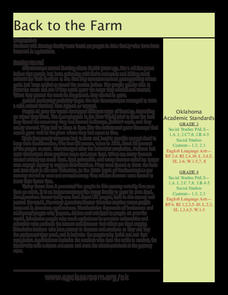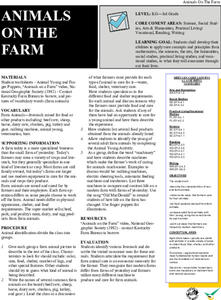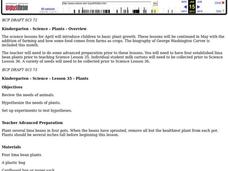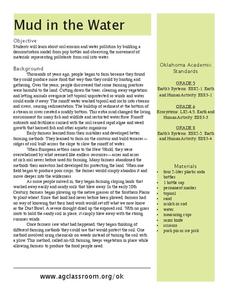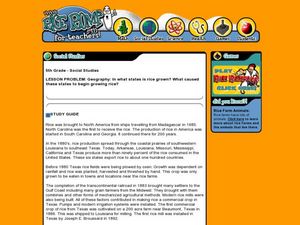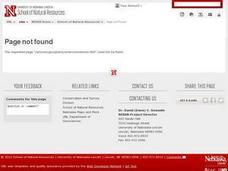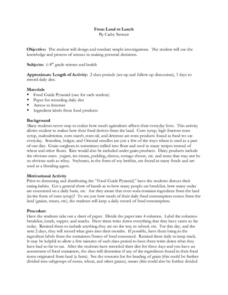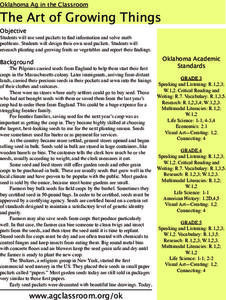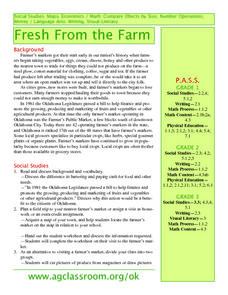Curated OER
Back to the Farm
Read up on farming and ranching and connect this information to your learners' lives. After reading, send class members home to fill out a family tree and trace their family history, focusing on farming and ranching backgrounds. Once...
Curated OER
Animals on the Farm
Students work in groups to create a description of a farm animal. Other classmates try to guess the animal. The class discusses what farmers need to provide for each animal on their farm (food, shelter, veterinary care). Students...
Kenan Fellows
Terrarium in a Bottle: Modeling the Atmosphere, Greenhouse Effect, and Water Cycle
You've heard of farm to table ... but what about farm in classroom? Junior agriculturalists embark upon a two-week journey into the science of growing things. Based upon the classic terrarium in a two-liter experiment, the lesson goes...
Curated OER
Plants
Students review the needs of animals, hypothesize the needs of plants, and set up experiments to test hypotheses.
Curated OER
Vegetable Twister
Students review vegetables and their nutrient values and production. In this vegetable production worksheet, students read information about the nutrients in vegetables and how they are grown. Students participate in a game of Twister to...
Curated OER
Listening to the Prairie
Students, in groups, visit an exhibit and for a prairie scavenger hunt to locate sunflowers and name products made from them. After sketching a prairie dog, they find nature cues farmers use when growing plants and raising animals. The...
Curated OER
Agriculture- It's More Than You Think
Students research careers in agriculture. In this agricultural lesson, students discover the various careers related to agriculture. Students construct resumes and "apply" for agricultural jobs.
Curated OER
Make a Farm Mural
Young scholars create farm mural that includes all the different things found on a farm.
Curated OER
Industrial Agriculture
Students write about the benefits that industrial agriculture has had on growing crops. In this industrial agriculture lesson plan, students research how technology has impacted the processing speed of growing food.
Curated OER
Mud in the Water
Sixth graders investigate erosion. For this erosion lesson, 6th graders explore how farming changes the environment. Students construct an erosion model and research ways to protect the soil from excess mud generated by farming.
Curated OER
Where is Rice Grown?
Fifth graders create a timeline of the development of rice as an important crop. In this agricultural history instructional activity, 5th graders read about the history behind why rice was grown and where it is grown. Students...
Curated OER
Why is rice important?
Second graders examine why rice is so important to the world. In this agriculture lesson, 2nd graders discover the origins of rice farming. Students study how many countries depend on rice for survival. Students research countries and...
Curated OER
Corn Field Math
Middle schoolers complete problems dealing with whole numbers, fractions and percents. After exploring the history of corn and related farming vocabulary, students work in pairs to solve multi-step problems. They incorporate the use of...
Curated OER
Defining Agriculture and Natural Resources
Students define agricultural using concept maps. For this agriculture lesson, students use concept maps to determine the ideas that are related to agriculture such as farming, food, flowers, and forestry before defining the word...
Curated OER
What Are We Looking At?
Learners investigate different perspectives through a farming simulation. In this photo perspectives lesson plan, students examine different photographs taken by satellite or from ground level. Learners then discuss the differences and...
Curated OER
Sustainability
Fifth graders investigate the concept of natural resources. They participate in a simulation project to see possible uses. They use the internet to study how Hacienda Verde is used as a model for others for sustainable coffee crops.
Curated OER
Contrasting Landscapes - UBC Farm Field Trip
Students visit the UBC Farm. For this lesson on various landscapes, students spend a day at the University of British Columbia exploring the farm and trail adjoining the campus. This lesson could be modified for use in any region that...
Curated OER
Soil Erosion Demonstrations
Students conduct experiments demonstrating soil erosion and the benefits of conservation practices. Working in groups, they use topsoil and sand in shallow boxes as models to examine the effects of water on soil and sand with and without...
Curated OER
Heartfelt/Handmade Activities: Genre Painting
Students examine genre painting. They explore the Illinois State Museum website, identify how genre paintings were composed, analyze the activities of an Illinois farm in the 1850s, and create a genre painting of current everyday...
Curated OER
From Land to Lunch
Students record their three meals and snacks for three days. They determine which items in their diets are grown on farms and record the items in various categories. They conduct Internet research to determine where carious ingredients...
Curated OER
The Art of Growing Things
Students discuss how the Pilgrims brought seeds, from England, into the new settlements and explore the history of seed nurseries. After observing packets of seeds and their contents, students list information found on the packets and...
Curated OER
Fresh From The Farm
Students investigate the concept of a farmer's market and how it used in the community. They conduct a survey to find the kinds of produce grown to be sold in the market. The lesson includes extensive introductory information for...
Curated OER
How Do Rice Farmers Grow Rice?
Second graders create rice bags using classroom objects. In this rice instructional activity, 2nd graders learn about how farmers grow their rice, and what hard work it is. Students learn about rice farmers all over the world and discuss...
Curated OER
Rice Plantation
Eighth graders study the importance of rice as a cash crop and the crop's dependency on slave labor during the settlement of coastal South Carolina. They explain the importance of the rice plantations to South Carolina's colonial economy.
